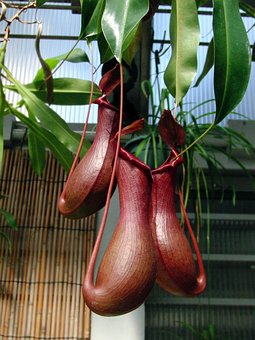 |
| Drosera - Sundew |
First is the Drosera genera also known as Sundew flower because they resemble the early morning dew covered flowers. They range in size from 5 mm for the Australian Drosera pygmaea to the 60 cm King Sundew.
The Drosera use their leaves to capture and digest the nutrients from insects. The dew like drops on the ends of the flowers is actually a gluey drop that releases a secretion when the insect lands on them. This substance contains an ingredient that paralyzes the insects. In addition the sundew can move their tentacles to curve around invading insects so as to maximize contact with them.
 |
| Nepenthes |
Next is the Nepenthes or tropical Pitcher plants. This is one of the largest insect eating plants found in the tropical areas of Asia. This plant tends to climb and grow up branches and trunks. It is also known as the "Monkey Cup" because people observed monkey's drinking out of these flowers.
The "pitchers" are made up of sword shaped leaves with a slick waxy cover above it. The cover is waterproof and emits a sweet scent that attracts insects. When insects get close enough, they end up sliding into the pitchers which have a syrupy liquid used to drown the creatures. Although the Nepenthes usually captures insects, the flowers occasionally manage to trap a rat or lizard.
This species covers several different types and colors. They are often hanging in trees or can even be found growing around felled trees.
 |
| Venus Fly Trap |
When the insect approaches the flower, all it has to do is touch the plant and the "trap" will spring capturing the insect or arachnid. As soon as the plant traps the insect, it identifies the creature and begins the digestion process which can take up to 72 hours to complete.
The size of this plant changes throughout the year. It reaches its largest size during the summer and has the brightest colors.
 |
| Cobra Plant |
When insects invade the plant due to it's sweet smell, they end up trapped and drown in the sap but it relies on symbiotic bacteria to absorb the nutrients rather than enzymes.
 |
| Butterwort. |
This plant captures flying insects such as moths, flies, and gnats. The Butterwort produces rosette shaped leaves and flowers from spring and summer. The flowers are found in white, yellow, and purple while the leaves attract insects due to their glistening leaves. When the insects land on the leaves, they become stuck and remain there until they die.
However, the plant goes through a carnivorous to non carnivorous and back cycle depending on the time of the year.
There are a few more carnivorous plants out there I'll cover sometime in the future. Let me know what you think. I'd love to hear from you. Have a great day.
No comments:
Post a Comment